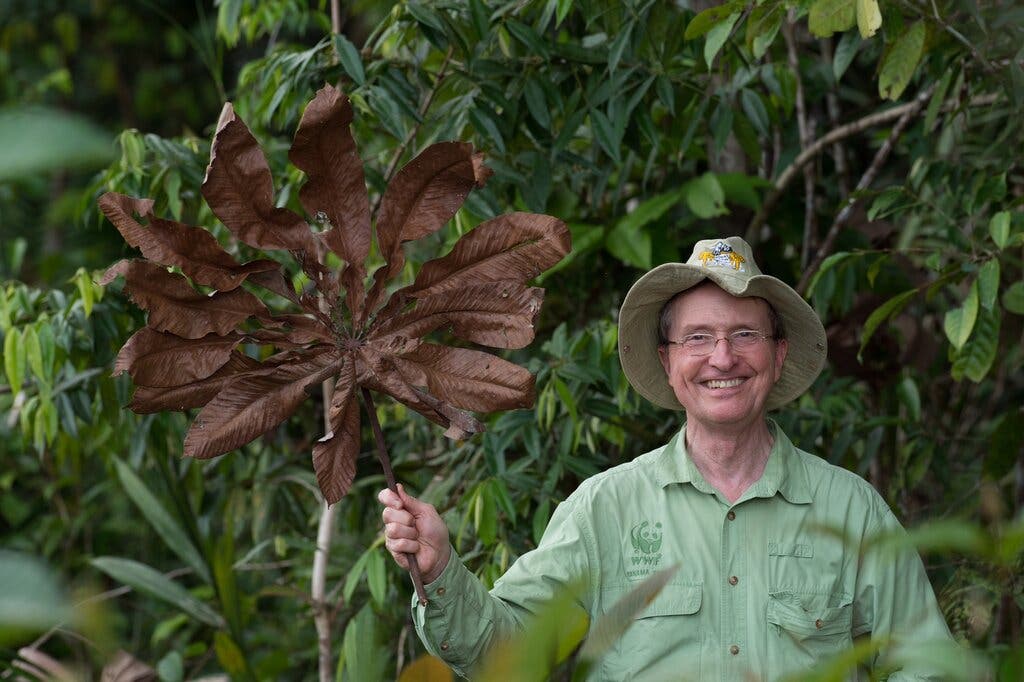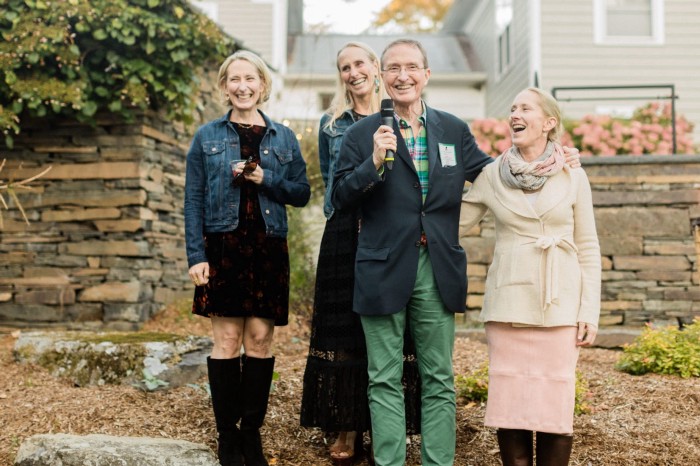
By P.J. Simmons, Co-Founder and Chair, CEF
The world lost an environmental superhero on Christmas day. And I lost one of my best friends and mentors: Dr. Thomas E. Lovejoy III.
Tom had been diagnosed with pancreatic cancer earlier this year, but the prognosis initially was rosy: “10+ more years,” the doctors said (or at least that’s the message my hopeful brain latched onto when he broke the news to me). In recent weeks, we were all stunned when his body took a rapid and unexpected downturn. Following a brief hospitalization, a coherent and headstrong Tom insisted last Thursday on returning home to his beloved “Drover’s Rest” in McLean, VA, allowing nature to take its course. Doctors expected him to have at least two weeks more — possibly even two months — so I made plans to visit on Christmas Day. He took his final breaths about two hours before I could arrive to tell him one last time how much I loved him, learned from him, and treasured our friendship. Thankfully, his final moments were spent peacefully by his living room fireplace with his family at his side.
Tom was truly a force of nature in every possible sense of the phrase.
A tireless champion for biodiversity and conservation, his work profoundly impacted the lives of countless individuals around the world — both human and non-human. His luminescent example inspired generations of students and practitioners. He was an extraordinary father and grandfather, raising three of the most wonderful humans I have ever met. And he was the most generous and thoughtful of friends, beloved by everyone who was lucky enough to be in his ecosystem.
I take some measure of comfort knowing that Tom unquestionably knew how deeply he was loved by his family and friends, who he inspired to reflect back the immense kindness, generosity, and joy he gave so freely and abundantly. And I’m glad that Tom also knew of his massive global impact on the challenges he cared so deeply about and worked so hard to help solve.
Unlike George in It’s a Wonderful Life, Tom needed no “Clarence” to help him see this, for he got confirmation literally every day. From past students and mentees whose careers he helped shape. From fellow scholars and scientists who lauded his definitive work. From Hollywood celebrities and Congresspeople who were transformed by the Amazonian adventures he took them on. From government officials around the world who sought his counsel. From CEOs who ramped up sustainability ambitions thanks to Tom’s gentle urging or writing. From awards juries who celebrated his stunning achievements. From strangers who would rush up to tell him after a talk how much his example and work had moved them.
Tom taught me so much during the nearly three decades I knew him. Here are a few of the most important lessons I’ll hold onto forever:
1. Strive to see the best in others you disagree with, and help forge common ground
Tom understood that we will never achieve the big, systemic changes needed for meaningful progress in conservation without big, diverse coalitions that cut across partisan and ideological divides. He had faith that, under the right circumstances, people with seemingly diametrical views could find a lot more to agree on than skeptics might assume — especially when it comes to common sense ideas around safeguarding Earth’s natural infrastructure. Tom genuinely valued differences of opinion because he recognized there were rarely black and white answers when it came to complex issues. And while he didn’t suffer fools, he spent his entire career patiently listening, humbly speaking, teaching not preaching, and respectfully challenging when disagreeing. In the process, he brought out the best in everyone he met, opening hearts and minds that otherwise would have stayed closed. Particularly now in our hyperpolarized United States, I draw great strength and inspiration from Tom’s measured approach in this regard — and resolve each day to try to emulate his example.
2. Magnify your impact by connecting great people
Tom delighted in bringing together electric mixes of people for carefully curated dinners, special events, and remarkable adventures. He did so in part to keep learning from others himself (his intellectual curiosity was insatiable). But most importantly, he took great pains to facilitate trusted introductions in the hopes of stimulating breakthrough thinking, to forge relationships among folks who might make some “good trouble” together, and to offer impact-driven individuals opportunities to re-energize and inspire each other. I had the great fortune of spending many an unforgettable evening around Tom’s dinner table, counting my blessings for the gift of meeting so many extraordinary people — many of whom would become lifelong friends and compatriots in the field of sustainability.
3. Nurture (and learn from) young professionals
If you were lucky enough to be mentored by Tom, you heard him speak with deep reverence for the mentors who were pivotal in his life like Frank and Janet Trevor, Evelyn Hutchinson, and Ruth Patrick. He clearly felt an inner calling to carry the torch and pay it forward. And did he ever. I wouldn’t be surprised if thousands of individuals around the world call Tom a cherished “mentor.” Because somehow — despite his grueling travel schedule and perennially packed diary — Tom regularly carved out generous amounts of time to help students and young professionals. He did so in ways that never felt rushed and that always made you feel like a respected colleague, as he genuinely valued learning from younger people with different life experiences and perspectives.

Tom Lovejoy hosting winners of CEF’s Leadership Development Immersion Program at his “Camp 41” Amazon research station in Brazil, July 2012
4. Stay hopeful, stay focused, and never give up
No one was more passionate than Tom about protecting biodiversity and halting damage to Earth’s ecosystems and climate. No one was more clear-eyed about the immense obstacles and disheartening signals pointing in the wrong direction. And yet Tom managed to maintain a glass-half-full sensibility, always choosing to look on the bright side and to choose hope over despair. I asked him a few times in recent decades how he did it. The answer was always basically the same: “What’s the alternative?” he’d reply. That simple question will always help inspire me to keep my head down and just keep doing the work.
5. Laugh hard and often
I think Tom’s ability to remain positive was directly correlated with his spectacular sense of humor. My memories of Tom all involve smiles, hearty laughter, and mischievous giggling. He was a gifted raconteur, and an equally talented joke-teller. I was relieved last night to see that the terrific Washington Post tribute to Tom included a reference to the candiru. I wouldn’t have raised it first, but let’s just say that if you knew Tom well, you also knew about that dastardly little creature and had probably choked on a drink or two laughing about it with him. If Tom could create space in his serious mind for so much joviality, so can (and should) we all.

Tom flanked by his spectacularly wonderful daughters (Kata, Annie, and Betsy) while speaking at my wedding in October 2018 — characteristically making everyone howl with laughter
6. Small, thoughtful gestures go a long way
In addition to regularly carving out ample time for family and friends, Tom was constantly finding unique ways to let those he cared about know he was thinking about them. Through his example, I learned what an impact a short, handwritten note can make on its recipient. I experienced the “make-your-day” impact of receiving a simple clipping in the mail of a Far Side or Rubes cartoon. I was the beneficiary of sidesplitting little gag gifts sent randomly during the year. Once again, I marvel at his ability to make time for these kinds of things so regularly for so many people. The fact that he did will always inspire me to keep family and friends top of mind every day, no matter how all-consuming work may feel — and to invoke Tom’s creativity in finding ways to remind them I love them.
7. Embrace nature’s wonder around you, everywhere and every single day
“Have you ever seen so many shades of green?” Tom asked us that question with childlike wonder at 6:00 am as we watched the Amazon rainforest wake up from a 30-meter high tower near his Camp 41 research station in Brazil. Sitting on the patio of his home 3,000 miles away in Virginia, Tom was just as prone to expressing starry-eyed wonder for the fireflies and frogs in his backyard. He saw the beauty and magic in life’s biological diversity everywhere he looked. He taught me to do the same. And for the rest of my life, whenever I hear a lyrical birdsong, marvel at a colony of ants, or smile at the sight of a gentle sloth…
I will see Tom.
Tom Lovejoy founded the Amazon Biodiversity Center in 2018 to carry on his world-changing work to train generations of conservation experts and provide sound science to decision makers to preserve biological diversity and ecosystems. You can make a donation in his memory here to the Amazon Biodiversity Center and post a message of your favorite memory of him or contribution to the Earth.
Read more about Tom Lovejoy’s Life and Legacy:
- “Thomas E. Lovejoy III, an ecologist who dedicated his career to preserving the Amazon rainforest, dies at 80,” Joshua Partlow, Washington Post, December 27, 2021
- “Thomas Lovejoy, Wide-Ranging Ecologist and Amazon Rescuer, Dies at 80,” Richard Sandomir, The New York Times, December 28, 2021
- “Honoring the Legacy of E.O. Wilson and Tom Lovejoy,” Elizabeth Kolbert, The New Yorker, December 28, 2021
